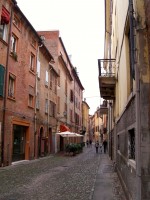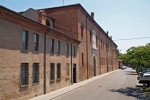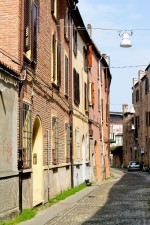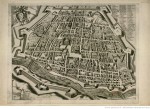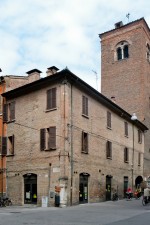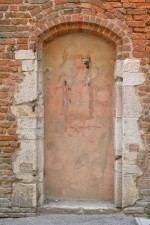House of Este’s Reception Policy
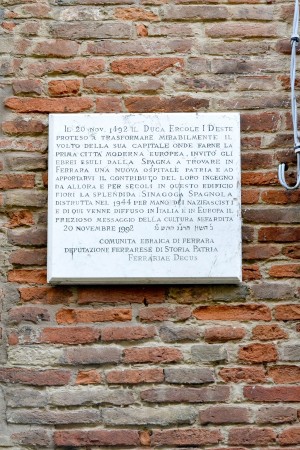
A plaque on the Spanish School in Via Vittoria 41 recalls Estense hospitality. Photograph by Edoardo Moretti, 2015. © MuseoFerrara
In the Este age, Jews expelled from Spain and Portugal were welcomed in Ferrara.
1. History
The Jewish presence in Ferrara has been documented since the thirteenth century, also underlined by a rule dated 1275 inserted into the statutes of 1287, by which the city government undertakes to observe the capitula quae continentur in instrument absolutionis et seu immunitatis facte Judeis ferrariensibus.
To the ‘Italian’ Jews, the Marquis d'Este – from Nicolò III to his sons Leonello and Borso – granted various privileges and decrees concerning in particular the conduct of loan banks, provisions that were renewed and updated over time. Since the first thirty years of the fifteenth century, one of the cornerstones of House of Este politics has been openness to enterprising and industrious immigrants, in order to always give new impetus to the economy of the State. At the end of the fifteenth century, under the rule of Duke Ercole I (1471-1505), the hospitality policy became more decisive with the consequent increase in the Community and the even more compact integration of Jewish families, thanks to a new decree that guaranteed Sephardic families expelled from Spain to exercise their activities with very broad privileges. The Jewish community remained firmly anchored in Ferrara until 1598, when the Duchy returned to the State of the Church.
2. Ferrara under the House of Este: the "safe harbour"
In 1492, while the Duke of Ferrara Ercole I d'Este (in government 1471-1505) began work on the great addition of Newfoundland which, on the project of the famous urban planner Biagio Rossetti, would have doubled the area of the city, the Catholic kings Isabella of Castile and Ferdinand II of Aragon expelled the Jews from Spain under a questionable pretext. The "Alhambra decree", in fact, provides for the ultimatum for conversion to Catholicism under penalty, within just four months, of leaving the Spanish land. Ferrara was on its way to becoming the capital of an extended Duchy, and Ercole was sure that the arrival of merchants and artisans can give new vigour to the economy of the eastern states. He decided to invite to Ferrara about twenty Spanish Jewish families who had been allowed to disembark in Genoa and who had been stuck, without food, on the dock of the port. According to popular memory, an important role in the story is played by the Duchess Eleonora d'Aragona, who supported her husband's policy of hospitality, in the hope that the Jews will bring to Ferrara "luxury shops and crafts to produce or import precious fabrics, embroidery and jewellery" (Balletti 1930, p. 76).
The memory of the two events is intertwined in the text of the marble tombstone placed five hundred years later, on 20 November 1992, in Via Vignatagliata, by the Jewish Community, the Ferrara Deputation of Homeland History and the Ferrariaæ Decus: "On 20 November 1492, Duke Ercole I d'Este, who wanted to admirably transform the face of his capital to make it the first modern European city, invited the Jews exiled from Spain to find a new hospitable homeland in Ferrara and to make the contribution of their ingenuity".
A few years later, in 1497, we witness the forced conversion of Portuguese Jews: the cristãos novos (converts of Jewish origin) try in every way to leave the Iberian Peninsula, pouring mostly into Antwerp which, over time, becomes not only "the centre of distribution of spices, but also the point of reception and sorting of cristãos novos towards hospitable countries" (Di Leone Leoni 2000, p. 286). It was the time of Duke Ercole II (in government 1534-1559), eager to imitate the example of Antwerp to place his States on the chessboard of international trade. He instructed the merchant Gerolamo Maretta to go to the Flemish city, officially to buy goods and horses, but with the real task of contacting Portuguese merchants, some of whom say they are ready to move to Ferrara, with the guarantee, however, that they can return to Judaism and not be investigated for religious reasons. The decree issued by the duke in 1538 reassures them: they would have been "safe and secure", and in Ferrara no one would have been interested in their way of doing it. Despite the enthusiasm and desire to move to Ferrara, the Portuguese of Antwerp feared the long journey through hostile countries, lands of Emperor Charles V, "obsessed with the idea that the Men of the Nation brought technology and the ‘secrets‘ of the Christian West to Turkey" (ibid., pp. 286-287). To circumvent the problem and the imperial police, Duke Ercole sought in vain the path of diplomacy and safeguards, then resolving to rely on a clandestine rescue network that organized the departure of Cristãos Novos from Portugal to Antwerp and from there to Ferrara, the last stage reached by hundreds of Marranos. Newcomers were granted extensive legal and administrative autonomy (1542) and immediately entered into business with the Ducal Chamber, in the wake of the ducal will to transform its city into a mercantile capital to be included in the trade routes between East and West.
Still, German Jews (1530), exiles from the Papal State (1569), those fleeing the Duchy of Milan and Naples (1589) found refuge in Ferrara.
Other events – including the plague and imperial decrees of expulsion – marked everyday life, but the city of the House of Este remained for the Jews the "safe harbour" where the ship that crossed the stormy sea depicted in the title page of Biblia Española, which left the Jewish presses in Ferrara in 1553, docked.
3. Quotes
"In 1492, due to the cruel and senseless expulsions of the Jews from Spain and Portugal, a good number of them sought a beneficial refuge in this city [Ferrara], and had it for the meekness of the House of Este Government, sponsor of the free exercise of Jewish worship, and for the goodness of the population. They were welcomed by these their brothers of religion with the greatest demonstration of affection to diminish the bitterness of abandonment of their respective homelands, the hardships and damages suffered". (Pesaro 1878-1880, p. 16)
"In 1543 Pope Paul III visited Ferrara. It was probably on this occasion that the duke [Ercole II] questioned him on the problem of the religion of the cristãos novos and on the validity of the baptism that had been imposed on them by force. According to a chronicle preserved in the Vatican Apostolic Library [Barb. Lat: 1369, Anonymous Chronicle, c. 179r] the pope would have claimed to ‘keep those people for Hebrews and not for Christians’ thus approving the duke's decision ‘that said Portuguese in his State could live as Hebrews freely". (by Leone Leoni 2000, p. 288)
Bibliography
- Balletti, Andrea, Gli Ebrei e gli Estensi, Poligrafica emiliana, Reggio Emilia 1930
- Pesaro, Abramo, Memorie storiche sulla Comunità israelitica ferrarese, rist. anast. dell'edizione Ferrara 1878-1880, Forni, Sala Bolognese (Bologna) 1986
- Leoni, Aron, Gli Ebrei a Ferrara nel XVI secolo, in Prosperi, Adriano - Chiappini, Alessandra (a cura di), Storia di Ferrara. VI. Il Rinascimento. Situazioni e personaggi, Corbo, Ferrara 2000, pp. 278-311
- Leoni, Aron di Leone, Graziani Secchieri, Laura, La nazione ebraica spagnola e portoghese di Ferrara (1492-1559), i suoi rapporti col governo ducale e la popolazione locale ed i suoi legami con le nazioni portoghesi di Ancona, Pesaro e Venezia, Olschki, Firenze 2011
Related places
Related Themes
Compiling entity
- Istituto di Storia Contemporanea di Ferrara
Author
- Edoardo Moretti
- Sharon Reichel

